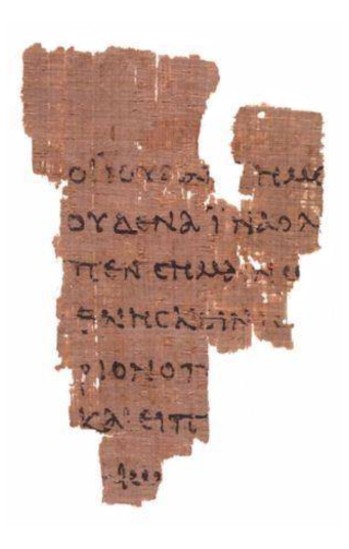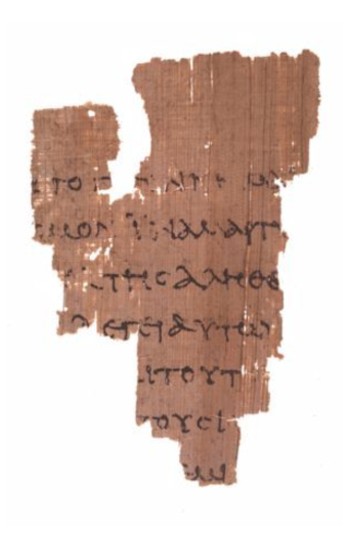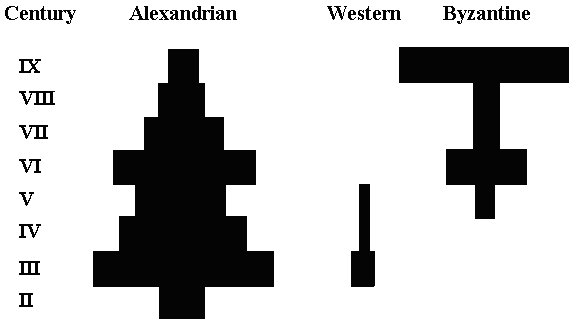                   |
A Case for the Circulation of the New Testament Papyri By James T. Bartsch, WordExplain.com
There are two competing
theories
with regard to the priority of the Greek text of the New Testament. The
vast majority of NT Greek manuscripts (MSS) belong to the Byzantine
family of texts,
for obvious reasons often called the Majority Text. If numbers of MSS
is the criterion for determining the textual tradition nearest to the
original autographs, the Majority Text wins hands down. In the words of
Hodges and Farstad, "Any reading overwhelmingly attested by the
manuscript tradition is more likely to be original than its rival(s)." 1 Similarly,
Maurice A. Robinson and William G. Pierpont published their
edition of the Greek New Testament based on the Majority Text in 1991.
In 2005, Robinson (Pierpont died in 2003) published an updated edition,
The New
Testament in the Original Greek: Byzantine Textform.
At the end of the edition, Robinson wrote an Appendix:
The Case for
Byzantine Priority,
pp. 533-586. In his Appendix, Robinson attempts to prove that the
Byzantine Text is the earliest Text Type. This is in opposition to the
theory espoused today by most
textual critics, which is that the Alexandrian text family is the
earliest
family, followed closely by the Western text family.
The Non-Priority of the Byzantine Text The theory that the Byzantine text family is the earliest text family runs aground on the reefs of historical facts. "First, among the Greek MSS, what is today the majority did not become a majority until the ninth century. Indeed, as far as the extant witnesses reveal, the Majority text did not exist in the first four centuries." 2 If the Byzantine text family were the earliest text family, we would expect to find at least some representation of it among the earliest Greek manuscripts, among the earliest versions (translations into other languages), and quotations among the earliest church fathers. But such is not the case. In fact, of the nearly 100 New Testament papyri discovered, more than fifty of them dating to before the middle of the fourth century, not one of them belongs to the majority text. What is Papyrus? Papyrus was used as a writing material for about 4,000 years. It was manufactured in sheets from the stem of a plant of the sedge family Cyperaceae Cyperus Papyrus. When completed, these sheets were stuck together into rolls. Papyrus is normally a resilient material. It was used for NT MSS until the eighth century. Up until 200, papyrus was the only material used. 3 The Provenance of NT Papyri Where have NT papyri come from? The "papyrus MSS survive only when protected from moisture - when placed in protective caves, jars, or buildings, or when buried in the soil of virtually rain-free regions of Egypt, Palestine, or Mesopotamia ...." All the NT papyri that have been discovered have been preserved in Egypt. A great many (28 of the total number of 94) of these were discovered in a garbage heap of the city of Oxyrhynchus on the so-called Canal of Joseph. The city was largely deserted when the water from the canal dried up. "Since all of our NT papyri were found in Egypt - though with few clues about their specific origin or precise use - the question has been raised whether they (and their texts) all originated in Egypt. This has generally been the assumption in the past, for the terms 'Egyptian' or 'Alexandrian text' to identify the 'B' or so-called Neutral text really meant 'the text of/from/characteristic of Egypt.'" Defenders of the priority of the Byzantine text family, of course, assume (without proof) that NT papyri originated in Egypt. Popular (not scholarly) defenders of the King James Version as the only legitimate version assume not only that the Alexandrian text originated in Egypt - they also assume that the Alexandrian text is corrupt, that it was corrupted by Origen, and that nothing from Egypt can be good because Egypt is "a type of the world." I have heard it argued by a KJV Only defender that the Alexandrian text must be rejected because God redeemed the people of Israel out of Egypt, and God delivered His Son out of Egypt. Therefore, according to them, the earliest text family could not possibly have come from Egypt. That level of argumentation is particularly unfruitful, it seems to me. KJV-Only defenders make a great deal of the preservation of the (Byzantine) text. I can very effectively argue that God preserved Israel in Egypt, and He preserved His Son in Egypt. So why could He not also have preserved the earliest and most original text type in Egypt? The point of this article The point that I wish to make is that the widespread and relatively speedy circulation of documents in the NT era was nothing short of remarkable. The greatest portion of the documents unearthed at Oxyrynchus "were tax receipts, invoices, all kind of correspondence including private letters; school texts, lists, etc." Detractors argue that the obviously wide-spread circulation of these non-biblical documents sheds no light on the circulation of the documents that make up the New Testament. I should like to answer that an ounce of evidence is worth a pound of speculation. The following is a very condensed list of papyri letters that have been found in Egypt. I have listed the letters in which the origin, the destination, the distance, and the time are all documented, with one exception. I believe this list strongly supports the probability that some, at least, of the Biblical papyri found in Egypt did not originate there, but that they arrived in Egypt from elsewhere in the Roman Empire. I believe the evidence supports the notion that there was a strong cross-pollination of biblical MSS in the NT era. Consider the evidence: Documented
Examples of Papyri Letters Circulated 260-240 BC
The NT
evidence for mobility and
circulation
The evidence presented in the NT for a mobile society in the Mediterranean area is quite remarkable. Consider the following: (1) The Ethiopian eunuch carried with him back to Africa from Jerusalem at least a copy of the scroll of Isaiah (Acts 8:26-40). (2) Phoebe carried Paul's letter from Corinth to Rome (Rom. 16:1-2). (3) Presumably Onesimus, the runaway slave, carried the letter from Paul in prison in Rome to Philemon, Onesimus' owner in Colosse (Philemon 1:1, 10-12). (4) It is possible that Silvanus carried Peter's letter from Peter in Rome to the "diaspora" of the provinces of northern Asia Minor (1 Pet. 1:1). (5) Paul wrote 2 Corinthians from Macedonia. He sent it to the church in Corinth presumably by the hand of Titus and two other brothers (2 Cor. 8:16-24). (6) Prisca (Priscilla) and Aquila traveled extensively in the Roman Empire. They hailed from Rome, but were forced to move out of Rome by Claudius' decree. Paul met them in Corinth on his second missionary journey (Acts 18:1-4). They traveled together to Ephesus (Acts 18:18-19). Later, when Paul wrote Romans, the couple had returned to Rome (Rom. 16:3). By the time Paul wrote his last letter to Timothy in Ephesus, he asked Timothy to greet Prisca and Aquila, presumably also back in Ephesus (2 Tim. 4:19). (7) It is clear that churches traded letters. Paul wrote to the Colossians, "When this letter is read among you, have it also read in the church of the Laodiceans; and you, for your part read my letter that is coming from Laodicea" (Col. 4:16). Conclusion In summary, let it be said that the mobility of individuals in the Roman empire in the first century was nothing short of remarkable, especially considering the antiquated modes of travel available to them. First century Christians had no telephones, no email capabilities, no fax machines, no cars, and no airplanes by which they could circumnavigate the Mediterranean. They did travel by sea, but they were limited to wind power and human oar power. Aquila and Priscilla alone illustrate the relative ease and frequency with which Christians of that era traveled. Their surprising mobility illustrates the method by which copies of New Testament Scripture would quickly make their way from one part of the empire to another. We have no way of proving the provenance of the NT papyri. It is possible that they were all copied in Egypt. But the evidence found in both secular and Biblical history makes it more plausible that there was cross-pollination of copies from one part of the empire to the other. In the providence and, dare I say, the preservation, of God, the earliest MSS that we have are papyri, and the papyri are predominantly Alexandrian in text-type. None of them are Byzantine in text-type. The circulation of documents in the Mediterranean help assure us that God preserved the earliest copies that He wished to preserve - and those copies are predominantly Alexandrian, not Byzantine, in their text-family orientation. 1
Zane C. Hodges and Arthur L. Farstad, The
Greek New Testament
According to the Majority Text
[2d ed.; Nashville: Nelson, 1985]); as quoted by Daniel B. Wallace,
"The Majority Text Theory: History, Methods, and Critique" in The Text of the New Testament in
Contemporary Research: Essays on the Status Quaestionis,
edited by Bart D. Ehrman and Michael W. Holmes, 1995, p. 310. Return
2 Wallace, p. 311. Return 3 Eldon Jay Epp, "The Papyrus Manuscripts of the New Testament" in The Text of the New Testament in Contemporary Research, pp. 3, 4. Return 4 Eldon Jay Epp, p. 6. Return 5 Eldon Jay Epp, p. 8. Return 6 Eldon Jay Epp, pp. 8-9. Return Go to The Text of the Bible Go to Bibliology Index Page Published June 8, 2012 Updated January 27, 2022 |
|||||||||||||||||||||||||||||||||||||||



